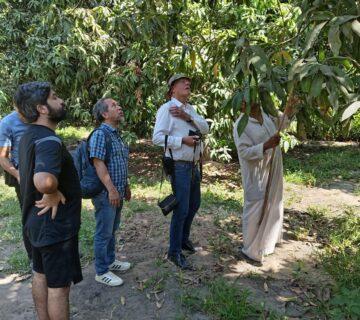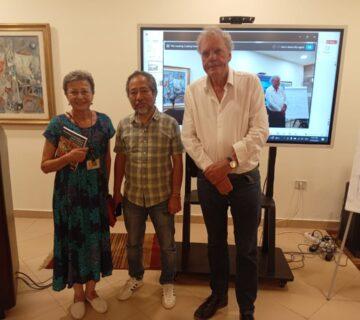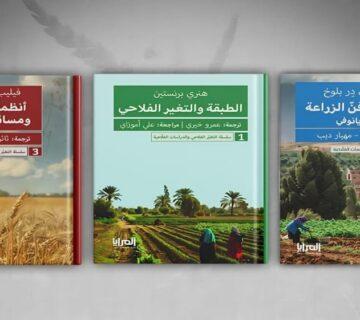SIYADA Network conducted an interview with director Wafa Kharfia about her new documentary: “I Am a Violator.” The film defends a fundamental right of small farmers, namely the right to land, and reveals the dreams and suffering of women farmers through the film’s main character, “Aunt Monjia,” a farm worker in the Ghannouch region of Gabès, Tunisia. Here is the text of the interview:
1. What is the story of the film and what about Monjia’s situation prompted you to make the film “I Am a Violator”?
The film tells the story of Manjia, a landless peasant woman who has been classified as a Violator by the state. It reveals her world and her efforts to reclaim salt marshes and turn them into fertile land, as well as the challenges she faces.
What attracted me to Monjia’s character and encouraged me to feature her in the film was her difference from other peasant women. Monjia was a farm worker who refused to accept the violence inflicted on her by her employers, refused subordination, and oppression. She decided to claim her “right to land,” which the state refused to grant her, and to work with a group of small landless peasants to exploit and cultivate state-owned farmland. She was the only woman in a group of men who took it upon themselves to cultivate the land without permission from the state.
Mongia is a woman in her sixties, a loving and cheerful person who cherishes life. She carries her will for freedom in the cracks of her hands. With all these qualities, she represents the daily struggle and perseverance in the face of arbitrary regimes. The film takes us into Monjia’s world, revealing her suffering in agricultural work. Monjia lives in an area where her land is classified as “unsuitable for agriculture,” but with her strong will, she has managed to turn it into fertile land from which she earns her daily livelihood. This land was not just a source of income for her, but became part of her identity, holding on to life and struggling against the conditions imposed on her by the state.
2. In your opinion, who should be allowed to use the land?
“The land belongs to those who work it” is a phrase that Monjia always repeats. In my opinion, and according to statistics, 80 percent of the agricultural workforce in Tunisia is made up of women, so the land should belong to them, first and foremost. Secondly, I believe that land should be in the hands of those who know how to use it well, manage it well, and control its resources. Therefore, it should be given to the real food producers, who are small farmers, especially women, because land provides women with an independent source of livelihood and protects them from economic dependence and violence against them as farm workers.
3. What problems do women farmers face in Tunisia?
The problems faced by women in Tunisia are many and varied, but if we talk about the problems of women farmers, they can be summarized as access to land, availability of financial resources, climate change that directly affects women in general and women farmers in particular, as well as the lack of social protection and transportation problems.
4. What difficulties did you encounter while filming?
In fact, I did not encounter any problems related to the main character of the film, “Monjia.” We worked together to prepare the character and the film for three years. The problems were related to the filming location, weather conditions, and the fact that filming took place during Ramadan, when the heat and wind affected the filming equipment. The biggest dilemma was financing, as the stages of preparing a film are diverse and long. The production and post-production stages require varied expenses. The film, which is 16 minutes long, actually took more than 20 hours of filming and 12 days of editing. All this shows that cinema is hard work and requires significant financial resources, but unfortunately we produced the film with modest means. All I could think about was that the issue the film presents is of great importance and must reach the viewer, and that is the goal.
5. How does cinema serve women’s struggle for land ownership?
Cinema is a complete language with its own images, music, and sound. I chose to listen to Monjia’s suffering and fears through the camera. I alternated between general shots of the place and closer, more intimate shots to capture the details of Monjia and her daughter’s work and their constant movement to bring life to a place that the state had classified as unsuitable for agriculture. They defy the salt and the harsh nature to create a life for themselves. Sometimes the camera was close to their faces, and other times it took a distance from them to focus on the movement of their bodies, which were so close to the ground that they almost seemed to emerge from it.
As for the music, I relied on the sounds of nature as sound effects, such as the sound of the wind, the tranquility of nature, and the sound of work tools. I used all of these effects to create the film’s music, through which the viewer identifies with the images and sounds, becomes captivated by the film, and empathizes with Monjia’s suffering and, by extension, with female farm workers around the world.
For me, cinema is a language capable of conveying our messages smoothly. A film does not need a visa to cross borders and travel. Art becomes true art when it reflects reality through its various mechanisms of sound, image, characters, and events, which are inherently synchronized with beauty. Its immortality, if I may say so, is its brilliance in pushing its infinite extension in the splendor of events, colors, and angles of reality.
In my opinion, ignoring human issues isolates art, especially cinema. I chose to make the film a social documentary because I believe in the power of cinema to bring change, especially documentary cinema, because it conveys human sincerity and accompanies human stories and pain. Since its inception, cinema has been authentic and truthful in its silent and persistent reflection of reality. It is the child of light and technology, and perhaps I did not go beyond the first moment in choosing a particular school in the sea of documentary cinema. Reality calls me, stories call me, and certain moments captivate me, so that in my view the most beautiful shots are those imbued with resistance, steadfastness, and struggle.
Ultimately, cinema remains a powerful tool with enormous potential to influence societies and change perceptions and values around major social issues. Women’s struggle for land ownership is not only a legal issue, but also a humanitarian issue related to justice and equality. By highlighting this issue in films, cinema can play an important role in highlighting the suffering of peasant women, encouraging social and legal change, and empowering women in their communities.
Through the stories that are presented, we find unconventional heroes; real heroes like peasant women who resist unjust circumstances and traditions. These stories can be a source of inspiration for all of us to continue working towards a more just world.




